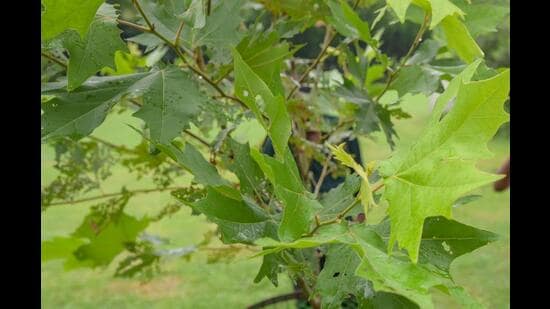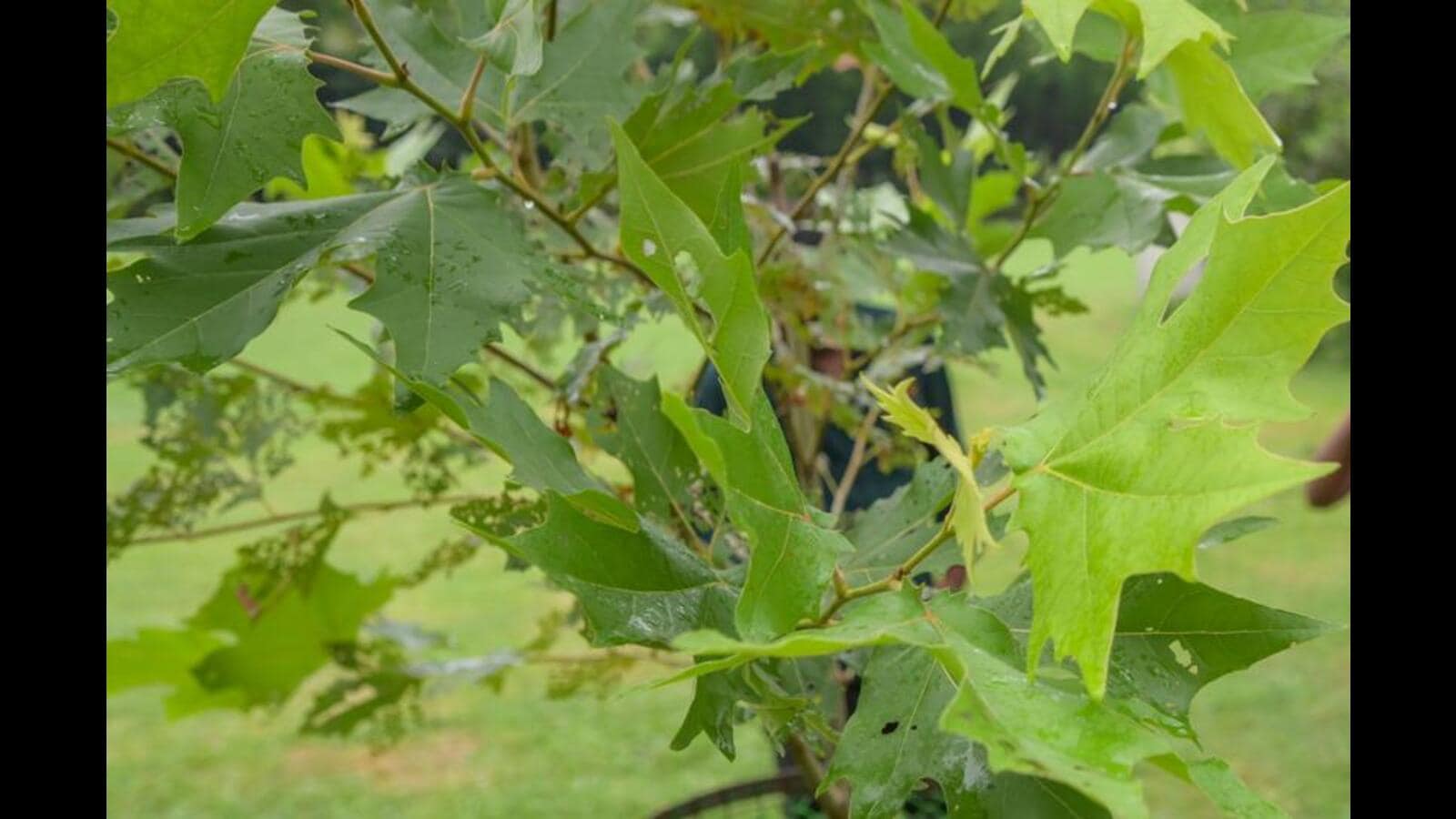In October 2023, saplings were planted at Nehru Park in New Delhi’s diplomatic enclave Chanakyapuri to mark India’s year-long G20 presidency, seen as a reflection of the country’s ascendance on the global stage.
 Chinar tree planted at Nehru Park in New Delhi’s Chanakyapuri. (RAJ K RAJ /HT PHOTO)
Chinar tree planted at Nehru Park in New Delhi’s Chanakyapuri. (RAJ K RAJ /HT PHOTO)
Envoys and representatives of the member nations planted saplings of national significance after the leaders of the G20 nations gathered in New Delhi for the grandest event the city had hosted since the 2010 Commonwealth Games.
A chinar, perhaps Delhi’s lone such tree, now stands out among those planted in 2023 at the park under the New Delhi Municipal Council (NDMC) jurisdiction. It has defied the adverse hot weather and grown 10 feet high two years after the French envoy planted it. The chinar also survived an insect attack and has grown woody with new sprouting branches. The Netherlands’ apple tree is also flourishing.
Chinar (Platanus Orientalis) and apple trees commonly thrive in cool regions such as Kashmir.
Also read | Delhi breathes its cleanest July air in 10 years
Most of the plants are doing well despite challenges such as bugs and squirrels. Experts have, meanwhile, pointed out that the one identified as African mahogany (Nigeria) is jamun (Syzygium cumini).
A weeping willow from the UK and the US’s queen crepe myrtle were on the verge of becoming full-scale trees. The German winterlinde and Australian golden wattle have also responded well.
Each tree requires a different climate and environment to thrive. Their natural habitat ranges from the Mediterranean and desert to tropical and subtropical environments. Squirrels, insects, and rain posed significant challenges to the growth of the trees.
Olive trees from Italy and Spain were doing better. Two date palms from Egypt and Saudi Arabia have adapted well, growing up to six feet. Some of the trees have not been as hardy in the face of Delhi’s extreme weather. A leafless frankincense (Oman) appears dead. The silver tree from South Korea has barely grown. A mango sapling from Bangladesh and a yellowwood (South Africa) have almost dried up.
Environmentalist Pradip Krishen, the author of the book “Trees of Delhi”, said the idea of introducing exotic species has never worked well. “They may survive, but they will never thrive. This is likely to be the case with the Chinar,” Krishen said. He said the plant shown as African mahogany (Nigeria) was a jamun.
Faiyaz Khudsar, who heads the Delhi Development Authority’s biodiversity parks project, also said that the plant appears to be jamun and not African mahogany.
Chandan Tiwary, who has been documenting trees in Delhi, said he was surprised to find a jamun growing where an African mahogany tree should have been. “Most trees are doing well. The chinar has grown. The olive trees also appear to be doing well. On the flip side, the silver tree is having a hard time. The Chinese camphor laurel is also struggling, but is likely to survive,” Tiwari said.
He added that several trees were not doing so well a year back. “A lot of them had dried up back then. Some are likely to have been replaced with new saplings,” he said.
An NDMC official said that the civic body had no role in the plantation or replacement of the saplings, and that they were only involved in protecting and basic upkeep. “The ministry of external affairs (MEA) got these trees planted through an external agency. They brought the saplings…many of these plants have done well with chinar becoming a unique addition to the garden.”
There was no immediate response from MEA. People familiar with the matter said the plant shown as mahogany was indeed brought from Nigeria. The Nigerian high commission did not respond to queries on the matter.
The saplings were kept in a double-layered protection, including a four-foot metallic cylindrical tree guard and a six-foot cuboidal geonet contraption bolted shut from all sides with the help of a white net. Most of the plants have outgrown the protective mini-enclosures. The top layer of the closed nets has been removed, as the plants have settled down.
